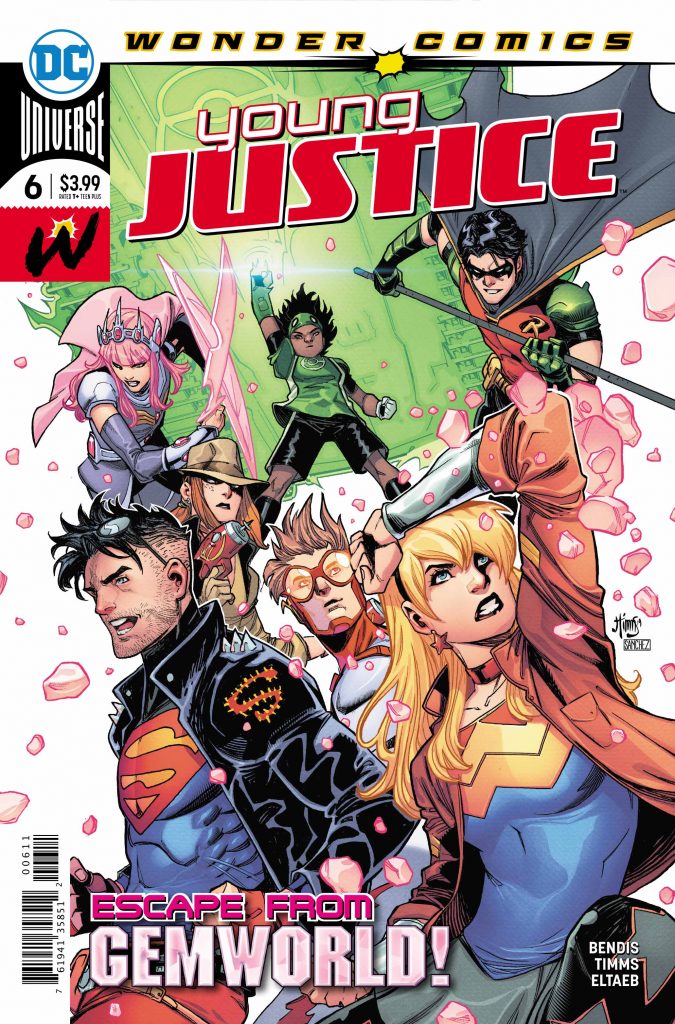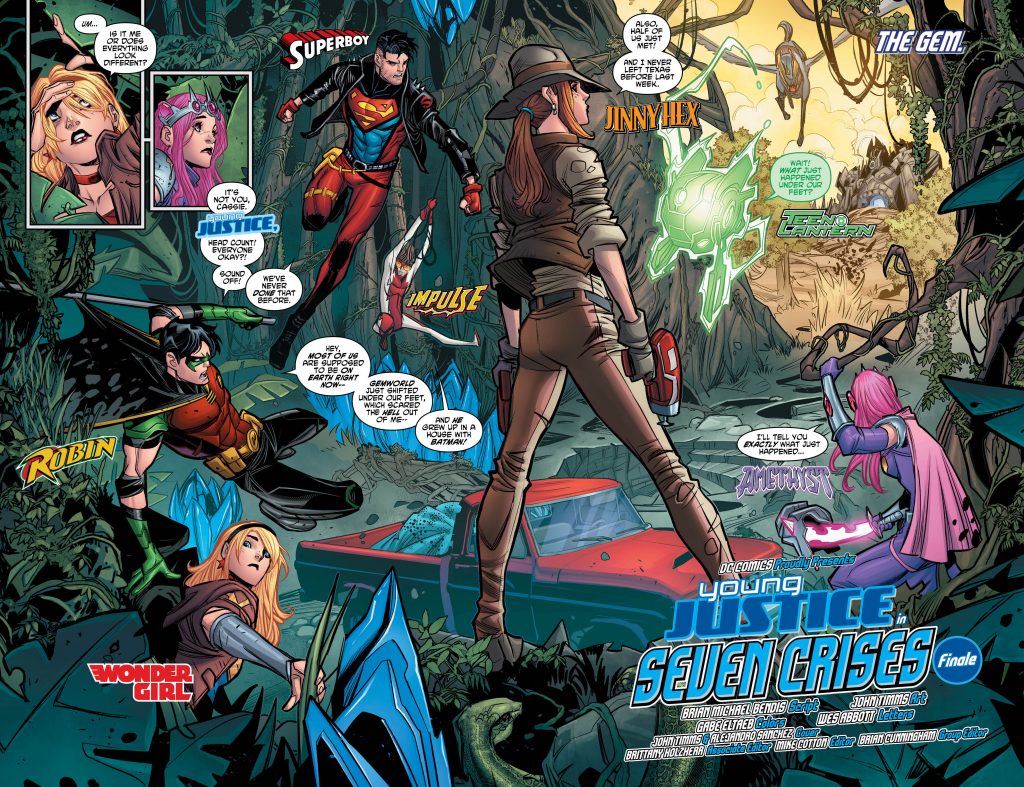Review: YOUNG JUSTICE #6

[Editor’s Note: This review may contain spoilers]
Script: Brian Michael Bendis
Art: John Timms
Colors: Gabe Eltaeb
Letters: Wes Abbott
Reviewed By: Ari Bard
Summary
It’s the epic conclusion to the arc that revived Young Justice! Can our heroes save Gemworld from the clutches of Lord Opal? How exactly does Connor Kent have a wife and son? Will Bart ever take anything seriously? All this and more in Young Justice #6!
Positives
A team of young heroes find themselves in a world unknown against a dark, insidious threat and no way of escaping. It isn’t exactly the most original concept, but it turns out to be exactly what this revival needed. Lord Opal has dangerous levels of power and a tight hold on the other houses of Gemworld, and it’s up to our young heroes to make thing right. With that, we have our arc’s final issue.
Brian Michael Bendis, John Timms, Gabe Eltaeb, and Wes Abbott have really tried to take a deep dive into Gemworld and have produced a book with a contagious sense of adventure. It’s a fun, constant feeling have in a title that has to balance seven young heroes readers are itching to see as well as a larger, multidimensional plot. Nevertheless, the pacing of this book remains strong. We’re getting more answers with every issue, and it’s exciting to learn what some of our favorite characters have been up to.
While Connor and Teen Lantern are the primary focus of this issue, Impulse is certainly the star. The team is able to have a ton of fun with the character whether it be via his dopey facial expressions, exaggerated poses, or hilarious dialogue. Impulse is one of Bendis’s best written young characters, and you can tell hope much fun he’s having with each issue. The team is able to add a lot of depth to this book through a lot of small, nuanced techniques such as the way Timms uses layering to create a 3D feel or some Wes Abbott’s neat little lettering flares that give the title some character when needed. The kinetic visual style within each panel is part of what gives Young Justice #6 its fun sense of adventure, and it’s a layout that continues to draw readers into the series.

Connor Kent is the strongest character in the issue for a number of reasons. He’s been a very divided subject since the appearance of Jonathan Kent with many craving his return and others asking what Connor’s purpose would actually be. In Young Justice #6, however, we get a chance to see that Connor Kent is, in fact, his very own hero. Not two second after landing in Gemworld does he agree to become a stranger’s husband to get her out of trouble. He then commits to that agreement for a lengthy but indefinite period of time while he tries to figure out how to get out of Gemworld. In this period of uncertainty, Connor Kent doesn’t channel his inner Superman; he channels his inner Clark Kent and his inner Pa Kent and returns to his roots for answers. The team delivers a touching, grounded moment in the presence of fantastical chaos, and it’s a pleasure to witness. Say what you will about Connor Kent and his history, but in Young Justice #6, he proves to be a real class act and a real joy to watch.
The primary narrative of this issue involves our heroes trying to learn more about each other and make sense of this new team while fending off the power of Lord Opal. This is a being that can bend reality, but it never feels like it. Our young heroes are worried, but this creative team uses a lot of bright colors and witty dialogue to keep the stakes fairly low. We see how Connor Kent became a husband, we hear how Teen Lantern got to wield, and we feel the electricity in the air as an Young Justice is officially back.
Negatives
The books conclusion in Gemworld leaves you wanting a lot more from these past six issues. Gemworld has always been a fun and fantastical corner of the DCU that’s seldom been explored. Unfortunately, we don’t get a lot of additional information besides the rough status of some of the houses and a look at the kingdoms of Amethyst, Opal, Emerald, and Turquoise. There’s a lot more to this world and a lot left to be explored, so hopefully we’ll be able to take a return trip somewhere down the line and explore all that this corner of the DCU has to offer.
Unfortunately, this book tends to feel a bit safe at times. Don’t let the idea of the “Wonder Comics” imprint fool you, Young Justice is a big title with even bigger implications, but Young Justice #6 doesn’t always live up to that hype. Lord Opal literally manipulates reality and instead of creating some mind-altering effects, everything just changes in an instant. There aren’t really any huge battle moments either, even against a living castle. Instead, we often get to see a few members fighting at a time while the rest are out of sight or behind cover. Young Justice #1 was this dazzling array of action, combat and chaos formed in panels that looked like the crystals coming out of Gemworld. The way panels overlapped and light refracted made Young Justice a completely new and exciting series, and you were hooked in an instant. Now the visual presentation is largely traditional with the occasional effect thrown in. Gemworld could be a huge opportunity to play with light and panel layouts in superhero comics, but instead we just get a medieval Earth-like world with more gems and a bit of magic.

There are also a lot of exposition-heavy moments that don’t need to be. The team attempts to craft moments of bonding while they are fighting Lord Opal but ends up removing a lot of the impact that both scenes have in the process. Teen Lantern’s origin, unlike the other flashbacks so far, is told instead of shown, and her character loses a lot of emotional depth because of it. It seems as though the creative team is being forced to choose between which parts to fully flesh out and which to cram into these 23-page issues, and it bring down the overall quality. The book isn’t hyper-compressed by any means, but it jumps from place to place too quickly, trying to give us a little piece of everything instead of a more satisfying, singular story.
Verdict
Young Justice #6 proves to be a solid but safe conclusion to the series’s first arc. Brian Michael Bendis has a lot on his plate at DC, but he’s still bringing oodles of fun to every issue while giving life to some of our favorite young heroes. Gabe Eltaeb makes Gemworld and Timms’s art shine and Abbott’s lettering adds a nuance of flare in a fun superhero book with a lot of potential that just needs to take a few more risks.
